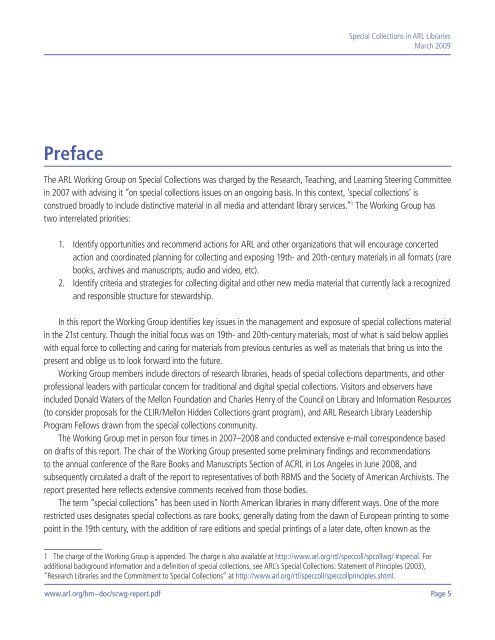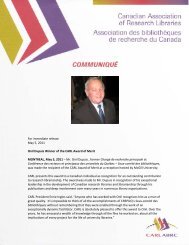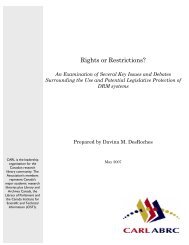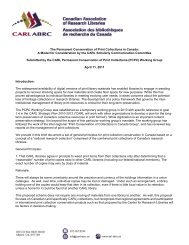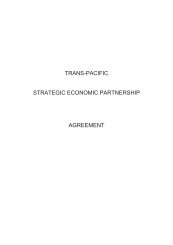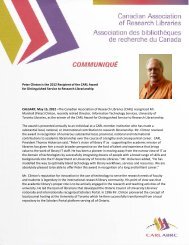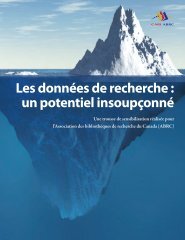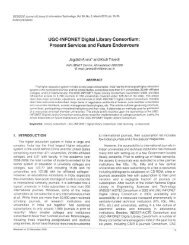PDF - CARL - ABRC
PDF - CARL - ABRC
PDF - CARL - ABRC
You also want an ePaper? Increase the reach of your titles
YUMPU automatically turns print PDFs into web optimized ePapers that Google loves.
Preface<br />
Special Collections in ARL Libraries<br />
March 2009<br />
The ARL Working Group on Special Collections was charged by the Research, Teaching, and Learning Steering Committee<br />
in 2007 with advising it “on special collections issues on an ongoing basis. In this context, ‘special collections’ is<br />
construed broadly to include distinctive material in all media and attendant library services.” 1 The Working Group has<br />
two interrelated priorities:<br />
1. Identify opportunities and recommend actions for ARL and other organizations that will encourage concerted<br />
action and coordinated planning for collecting and exposing 19th- and 20th-century materials in all formats (rare<br />
books, archives and manuscripts, audio and video, etc).<br />
2. Identify criteria and strategies for collecting digital and other new media material that currently lack a recognized<br />
and responsible structure for stewardship.<br />
In this report the Working Group identifies key issues in the management and exposure of special collections material<br />
in the 21st century. Though the initial focus was on 19th- and 20th-century materials, most of what is said below applies<br />
with equal force to collecting and caring for materials from previous centuries as well as materials that bring us into the<br />
present and oblige us to look forward into the future.<br />
Working Group members include directors of research libraries, heads of special collections departments, and other<br />
professional leaders with particular concern for traditional and digital special collections. Visitors and observers have<br />
included Donald Waters of the Mellon Foundation and Charles Henry of the Council on Library and Information Resources<br />
(to consider proposals for the CLIR/Mellon Hidden Collections grant program), and ARL Research Library Leadership<br />
Program Fellows drawn from the special collections community.<br />
The Working Group met in person four times in 2007–2008 and conducted extensive e-mail correspondence based<br />
on drafts of this report. The chair of the Working Group presented some preliminary findings and recommendations<br />
to the annual conference of the Rare Books and Manuscripts Section of ACRL in Los Angeles in June 2008, and<br />
subsequently circulated a draft of the report to representatives of both RBMS and the Society of American Archivists. The<br />
report presented here reflects extensive comments received from those bodies.<br />
The term “special collections” has been used in North American libraries in many different ways. One of the more<br />
restricted uses designates special collections as rare books, generally dating from the dawn of European printing to some<br />
point in the 19th century, with the addition of rare editions and special printings of a later date, often known as the<br />
1 The charge of the Working Group is appended. The charge is also available at http://www.arl.org/rtl/speccoll/spcollwg/ #special. For<br />
additional background information and a definition of special collections, see ARL’s Special Collections: Statement of Principles (2003),<br />
“Research Libraries and the Commitment to Special Collections” at http://www.arl.org/rtl/speccoll/speccollprinciples.shtml.<br />
www.arl.org/bm~doc/scwg-report.pdf Page 5


